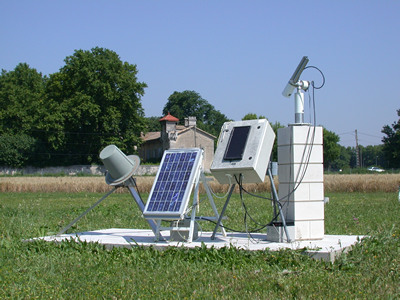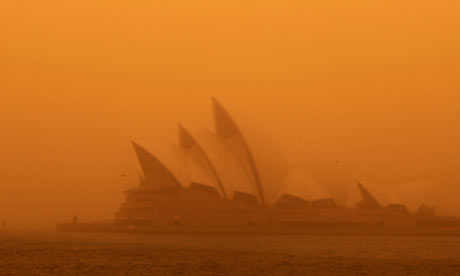Introduction |

"AERONET - the AERONET (AErosol RObotic NETwork) is a network of ground-based sun photometers which measure atmospheric aerosol properties. The measurement system is a solar-powered CIMEL Electronique 318A spectral radiometer that measures Sun and sky radiances at a number of fixed wavelengths within the visible and near-infra red spectrum. There is one sea-based reading location aboard the E/V Nautilus, the exploration vessel operated by Dr. Robert Ballard and the Sea Research Foundation. Two readings per day are taken aboard the ship while it is in operation. AERONET provides continuous cloud-screened observations of spectral aerosol optical depth (AOD), precipitable water, and inversion aerosol products in diverse aerosol regimes. Inversion products are retrieved from almucantar scans of radiance as a function of scattering angle and include products such as aerosol volume size distribution, aerosol complex refractive index, optical absorption (single scattering albedo) and the aerosol scattering phase function. All these products represent an average of the total aerosol column within the atmosphere. The aerosol properties are retrieved via an inversion algorithm developed by Dubovik and King (2000). Further algorithms were developed, for example, by Dubovik et al. (2006) to take into account non-spherical shapes of aerosol particles such as mineral dust. AERONET is an observing system in the NOAA Observing from AERONET to System Architecture. "
Citation: Wikipedia "AERONET"
 "A dust storm or sand storm is a meteorological phenomenon common in arid and semi-arid regions. Dust storms arise when a gust front or other strong wind blows loose sand and dirt from a dry surface. Particles are transported by saltation and suspension, a process that moves soil from one place and deposits it in another. The Sahara and drylands around the Arabian peninsula are the main terrestrial sources of airborne dust, with some contributions from Iran, Pakistan and India into the Arabian Sea, and China's significant storms deposit dust in the Pacific. It has been argued that recently, poor management of the Earth's drylands, such as neglecting the fallow system, are increasing dust storms from desert margins and changing both the local and global climate, and also impacting local economies. The term sandstorm is used most often in the context of desert sandstorms, especially in the Sahara, or places where sand is a more prevalent soil type than dirt or rock, when, in addition to fine particles obscuring visibility, a considerable amount of larger sand particles are blown closer to the surface. The term dust storm is more likely to be used when finer particles are blown long distances, especially when the dust storm affects urban areas."
"A dust storm or sand storm is a meteorological phenomenon common in arid and semi-arid regions. Dust storms arise when a gust front or other strong wind blows loose sand and dirt from a dry surface. Particles are transported by saltation and suspension, a process that moves soil from one place and deposits it in another. The Sahara and drylands around the Arabian peninsula are the main terrestrial sources of airborne dust, with some contributions from Iran, Pakistan and India into the Arabian Sea, and China's significant storms deposit dust in the Pacific. It has been argued that recently, poor management of the Earth's drylands, such as neglecting the fallow system, are increasing dust storms from desert margins and changing both the local and global climate, and also impacting local economies. The term sandstorm is used most often in the context of desert sandstorms, especially in the Sahara, or places where sand is a more prevalent soil type than dirt or rock, when, in addition to fine particles obscuring visibility, a considerable amount of larger sand particles are blown closer to the surface. The term dust storm is more likely to be used when finer particles are blown long distances, especially when the dust storm affects urban areas."
Particles become loosely held mainly due to drought or arid conditions, and varied wind causes. Gust fronts may be produced by the outflow of rain-cooled air from an intense thunderstorm. Or, the wind gusts may be produced by a dry cold front, that is, a cold front that is moving into a dry air mass and is producing no precipitation--the type of dust storm which was common during the Dust Bowl years in the U.S. Following the passage of a dry cold front, convective instability resulting from cooler air riding over heated ground can maintain the dust storm initiated at the front. In desert areas, dust and sand storms are most commonly caused by either thunderstorm outflows, or by strong pressure gradients which cause an increase in wind velocity over a wide area. The vertical extent of the dust or sand that is raised is largely determined by the stability of the atmosphere above the ground as well as by the weight of the particulates. In some cases, dust and sand may be confined to a relatively shallow layer by a low-lying temperature inversion. In other instances, dust (but not sand) may be lifted from a dust storm to 20,000 feet (6,100 m) high.
Citation: Wikipedia "Dust Strom"